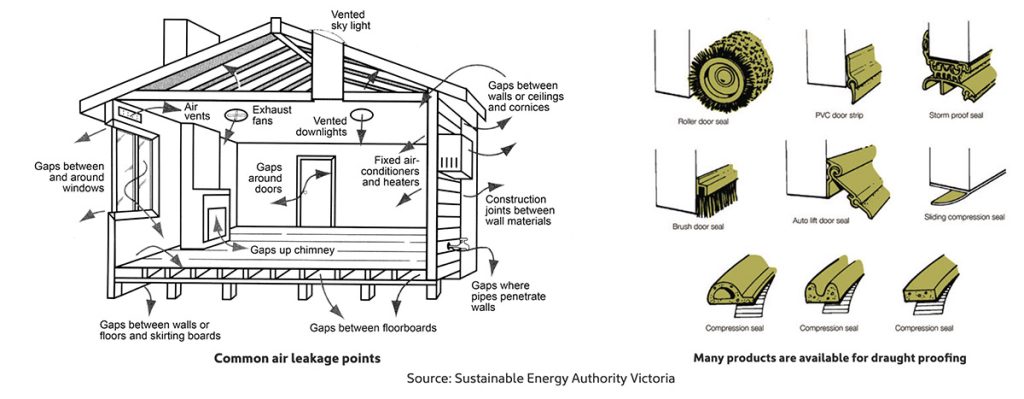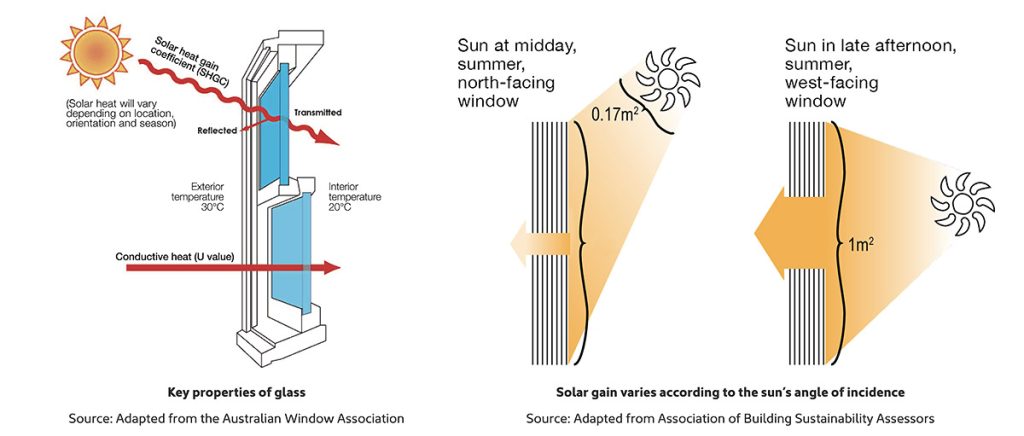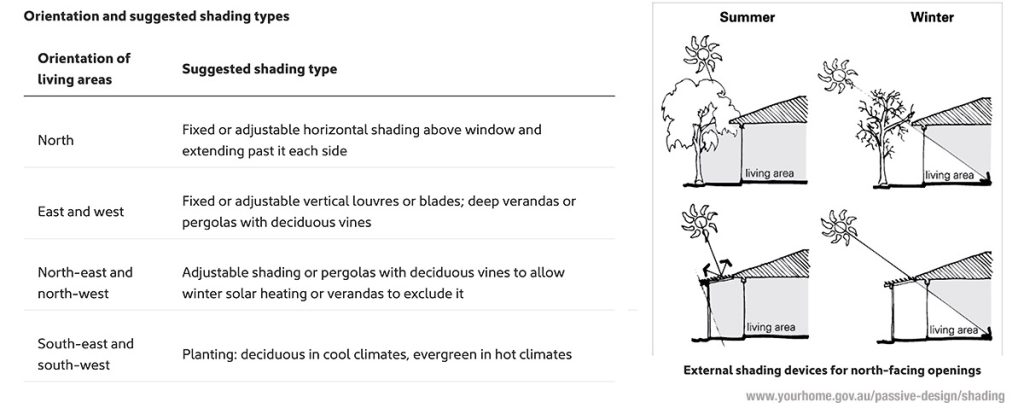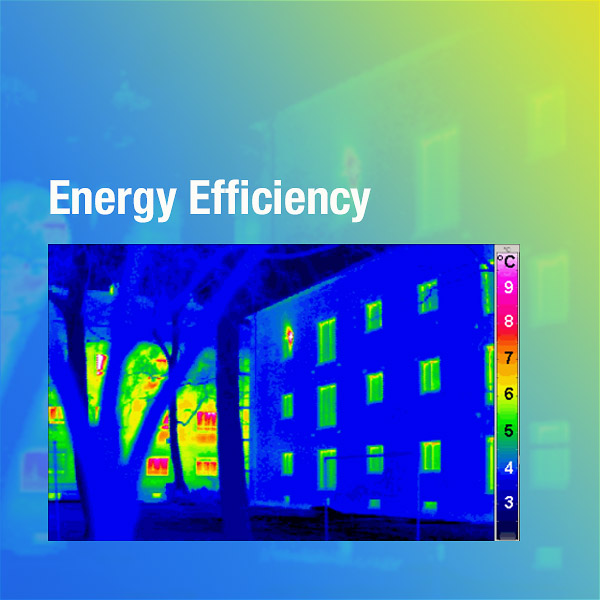Simple steps can make your home warmer in winter, cooler in summer, lower energy costs, reduce dust, vermin, bugs and noise.
Draught Proofing
What are draughts?
Draughts are uncontrolled outside air entering our homes through gaps and holes. They differ from controlled ventilation from windows, doors and ducted vents with back draft flaps.
Sealing the gaps and holes that cause draughts is a DIY job that improves comfort, lowers energy costs and reduces dust, vermin, bugs and noise.
Rooms with appliances that burn gas or wood shouldn’t have their fixed ventilation sealed because of the noxious fumes given off by these appliances when in use.
Draught Proofing: six simple ideas from Sustainability Victoria
Sustainability Victoria lists some easy ways to find draughts:
“Look for obvious gaps
Visible light under and around doors and windows is a good clue.Listen for rattles or whistling
Take time out, especially during strong winds, to listen for rattles and whistling around doors and windows.Feel for moving air
Feel around doors, windows, fireplaces, air outlets, vents, stairways, floorboards, exposed rafters and beams, built-in heaters and air conditioners, architraves and skirting boards.Look for movement in curtains
Movement in and around curtains can be an indicator of draughts”.
Balancing Airtightness and Ventilation
If a home is airtight, but poorly ventilated, there are higher risks of condensation and mould.
Ventilation includes natural ventilation from windows and doors, and mechanical ventilation including exhaust fans, positive pressure air replacement and mechanical ventilation heat recovery systems.
Poor ventilation impacts our respiratory health.
As the federal government Your Home website notes:
“If not paired with adequate ventilation, increased airtightness can also lead to the build-up of gases, toxins and pollutants, which can trigger respiratory health issues. Toxic substances include:
• carbon monoxide, sulfur dioxide and nitrogen oxide from heating and cooking
• volatile organic compounds (VOCs) and formaldehyde emissions from furniture, carpet, finishes and building material
• airborne toxins from household cleaners
• pollen, dust and dust mites.”

Instructional Videos
Ecomaster’s Draught Proofing Your Home in Winter page, lists quite a number of thorough instruction sets with videos including draught sealing an aluminium door. how to draught proof a cavity sliding door, and how to draught stop exhaust fans.
Eco Evo Design also has a useful range of videos including one on ducting heating:
Insulation
Insulation reduces the transfer of heat. This resistance to heat transfer is expressed as an R value. The higher the R value – the more resistance to heat transfer.
Insulating ceilings, floors and walls helps to keep our homes more comfortable in both winter and summer, lowers energy costs and reduces noise
Bulk insulation works by trapping air. To be effective it needs to be installed with close attention to detail – making every effort to ensure that there are no gaps or compression of the insulation.
For example – gaps totalling only 5-10% reduce the R value of the insulation between 30-50%.
- The Your Home website offers more details on insulation and R value
- You can read more about bulk insulation here.
- Check out this Energy Matrix page on finding gaps in your insulation
Here is an Eco Evo video on fixing gaps on insulation:
Ceiling Insulation
Sustainability Victoria says that ceiling insulation will save you up to 20% on your heating and cooling costs. Your insulation may have settled and may be not be performing very well. Before inspecting you roof cavity it is important to be aware of safety – check out Sustainability Victoria’s health and safety tips here. If the height of your insulation is less than 50cm it should be topped up – chose products with low toxicity, and make sure have enough space so the product is not compressed.
Reasons to insulate your home
Ecomaster lists seven important reasons for insulating your home:
- Energy efficiency – using less energy
- Improved thermal comfort
- Financial benefits for buyers and sellers – 10% improvement in property prices according to the University of Wollongong
- Improved health – especially less impact on respiratory and endocrine systems and skin from mould and damp
- Lower energy costs
- Reduced noise levels
- Reduce greenhouse gas emissions
Renew Articles
This Renew article explains principles of heat transfer and insulation.
Check out this article on 15 tips to lower energy bills and stay warm in winter including simple actions such as heated throws for working at a desk. Read Renew’s Heat people not places article for more ideas. Another hint is to switch on your reverse cycle air conditioner’s heat mode instead of using gas space heating.
Upgrading Window Performance
Glass is a poor insulator, a layer of still air improves thermal performance
Windows let in welcome daylight and fresh air, and frame outside views. Unfortunately glass offers very poor resistance to heat transfer, with a very low R value of R0.2
This can be improved by strategies that hold a layer of still air next to the glass including window film, curtains with pelmets (including invisible pelmets), honeycomb blinds fitted within the window reveal and double glazing or secondary glazing.
Heat transfer
This Renew buyers guide on windows notes that the Australian Window Association (AWA) “estimates up to 40% of a home’s heating energy can be lost through windows and up to 87% of its heat gained through them”.
Heat is lost in the following ways:
- Indirect radiation, where inside warmth (long wavelengths) is transferred to the outside via the pane of glass, or the reverse in summer. Unfortunately short wavelengths easily pass through glass, such as visible light and near-infrared radiation.
- Heat is also lost by conduction, especially through aluminium window frames which have no thermal break. Aluminium conducts heat six times more readily than glass! This is worse in winter because warm heat falls through the floor near a window – this convection current is responsible of a lot of heat loss.
- The final method is through air infiltration or leaks.

U values
The best indicator of window performance is the U value, the inverse of the R value. The lower the U value – the higher the resistance to heat transfer.
Curtains or blinds
Thick curtains certainly help reduce heat loss, particularly if they are fitted into a pelmet and drape to the floor. It is also effective to fit a strip of wood between the window frame and the curtain track or consider invisible pelmets.
Honeycomb blinds trap a layer of air if fitted within the window reveal, and are very effective.
Secondary glazing
There are a variety of secondary glazing products, some commercially installed, some DIY, that can be applied to the interior of windows. Consider Clear Comfort film or Magnetite acrylic sheets which are removable for cleaning if you are looking at DIY. There are systems like Sound Barrier or Stop Noise that are aimed at noise reduction.
High performance windows
It is worth consulting a professional for an accurate assessment of the technical requirements for optimum performance if you are going to go to the expense of high performance windows, which can be particularly expensive in retrofits. Other options such as wall insulation, shading, blinds, pelmets or secondary glazing should be considered first. For more information check out this Your Home page and Renew guide to high performance windows and glazing.
Shade and direction matter
Reducing direct sunlight on windows in summer is important to keeping cool. The shading strategy depends on which direction the window faces.
This article from Sanctuary magazine details a variety of attractive external shading treatments, from foliage, slats or battens that “animate the space”, as well as fixed or adjustable seals, louvres or awnings and eaves. Of course deciduous plantings are an important option, depending on your land, building orientation, fire safety and other climate factors.
Check out this Renew external shading buyers guide here.
This Your Home page provides a good guide for understanding the effect of latitude and orientation on shading requirements.

Getting Started
Check out the Energy Tips website for a variety of DIY videos to help you make simple changes at home.
Disclaimer
Please note that whilst Lighter Footprints has endeavoured to ensure all information in this blog is correct, individual circumstances will vary and it is important that you undertake your own research to best cater for your situation and preferences. Health and safety considerations are paramount and you must consider whether DIY is suitable for you.

